DODGE TRUCK 1993 Service Repair Manual
Manufacturer: DODGE, Model Year: 1993, Model line: TRUCK, Model: DODGE TRUCK 1993Pages: 1502, PDF Size: 80.97 MB
Page 1261 of 1502
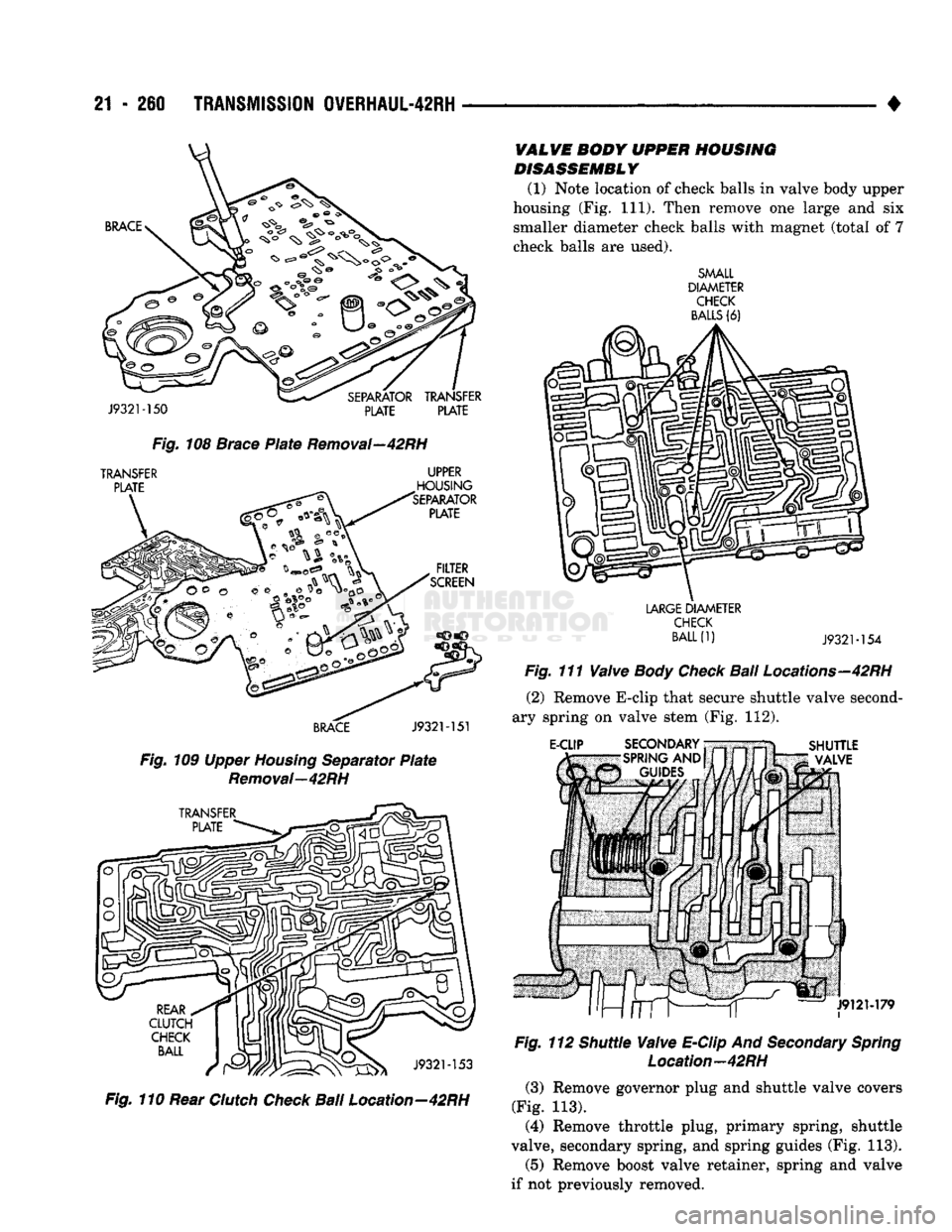
21
- 260
TRANSMISSION
0VERHAUL-42RH
•
BRACE
J9321-150
SEPARATOR
TRANSFER
PLATE PLATE
Fig.
108 Brace
Plate
Removal—42RH
TRANSFER
PLATE
UPPER
HOUSING
'SEPARATOR
PLATE
FILTER
SCREEN
BRACE
J932M51
Fig.
109 Upper
Housing
Separator
Plate
Removal—42RH
TRANSFER
PLATE
REAR
CLUTCH
CHECK
BALL
Fig.
110 Rear
Clutch
Check
Ball
Location—42RH
VALVE
BODY UPPER HOUSING
DISASSEMBLY
(1) Note location of check balls in valve body upper
housing (Fig. 111). Then remove one large and six
smaller diameter check balls with magnet (total of 7
check balls are used).
SMALL
DIAMETER
CHECK
BALLS
(6)
LARGE
DIAMETER
CHECK
BALL
(1)
J9321-154
Fig.
111
Valve
Body Check
Ball
Locations—42RH (2) Remove E-clip that secure shuttle valve second
ary spring on valve stem (Fig. 112).
E-CLIP
SECONDARY
SHUTTLE
VALVE
J9121-179
Fig.
112 Shuttle
Valve
E-Clip And
Secondary
Spring
Location—42RH
(3) Remove governor plug and shuttle valve covers
(Fig. 113). (4) Remove throttle plug, primary spring, shuttle
valve, secondary spring, and spring guides (Fig. 113).
(5) Remove boost valve retainer, spring and valve
if not previously removed.
Page 1262 of 1502
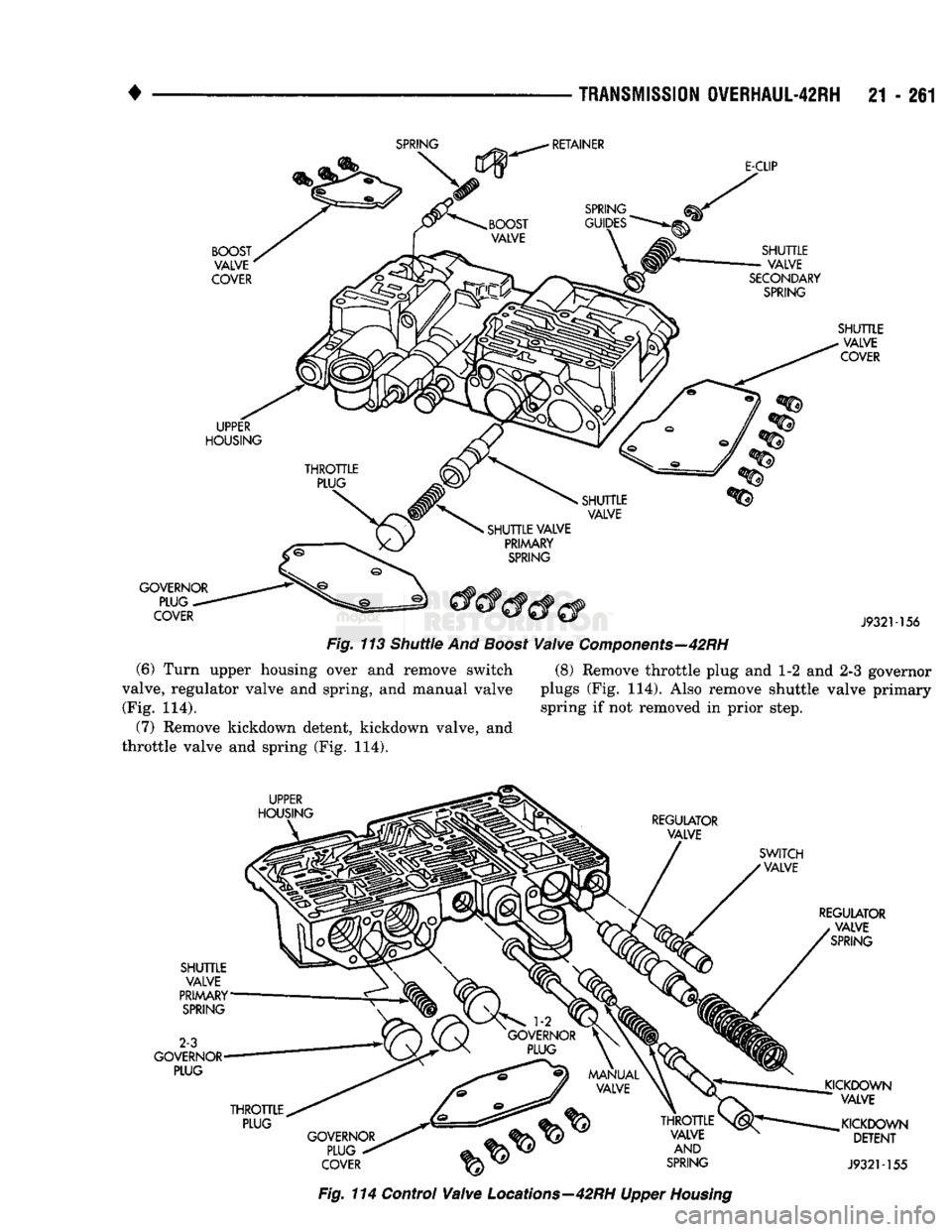
•
TRANSMISSION
OVERHAUL42RH
21 - 261 -156
Fig. 113 Shuttle And
Boost
Valve Components—42RH
(6) Turn upper housing over and remove switch (8) Remove throttle plug and 1-2 and 2-3 governor
valve, regulator valve and spring, and manual valve plugs (Fig. 114). Also remove shuttle valve primary (Fig. 114). spring if not removed in prior step.
(7) Remove kickdown detent, kickdown valve, and
throttle valve and spring (Fig. 114). Fig. 114 Control Valve Locations—42RH Upper Housing
Page 1263 of 1502
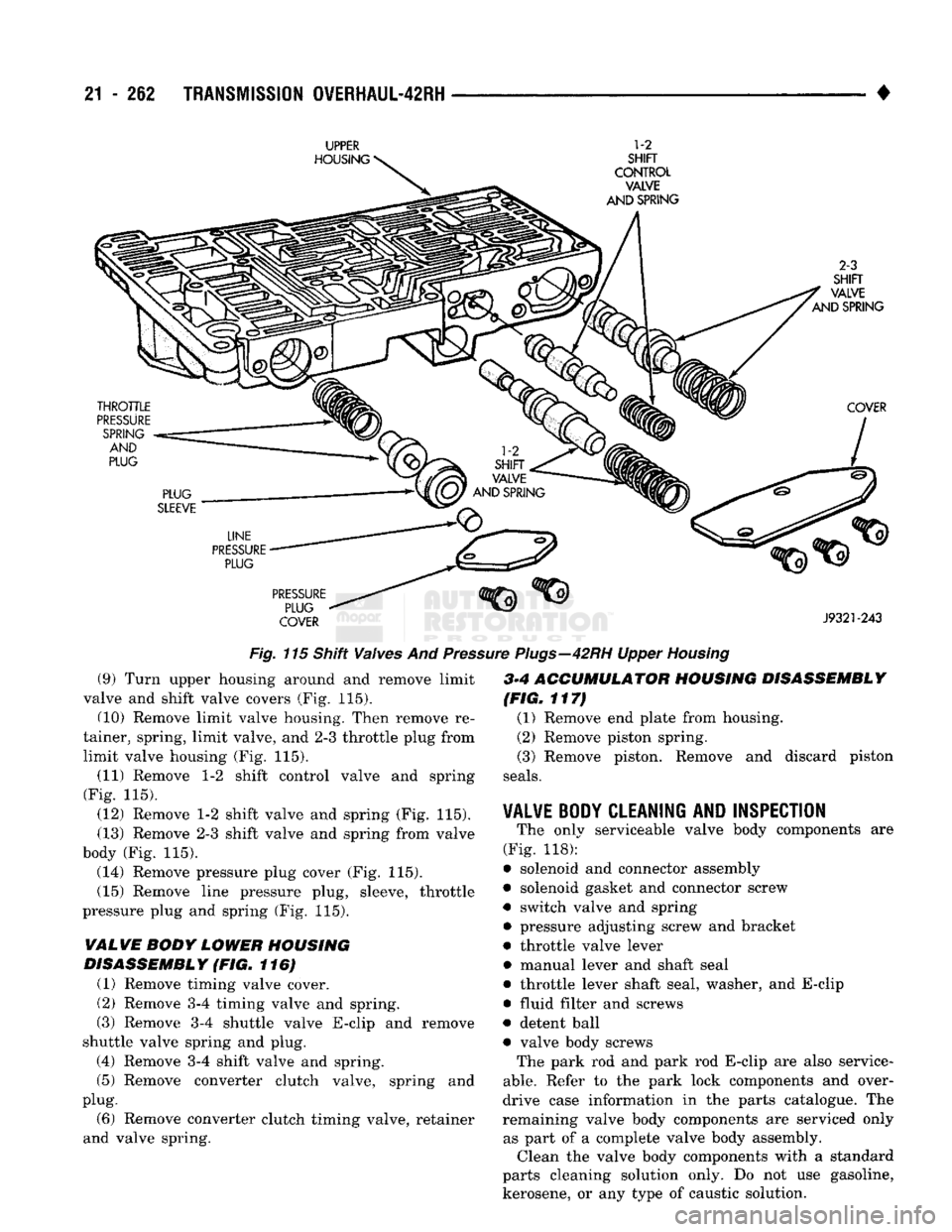
21
- 212
TRANSMISSION OWERHAUL-42RH
UPPER
HOUSING
1-2
SHIFT
CONTROL VALVE
AND SPRING
2-3
SHIFT
VALVE
AND SPRING
THROTTLE
PRESSURE
SPRING
AND
PLUG COVER
PLUG
SLEEVE
LINE
PRESSURE
PLUG
PRESSURE
PLUG
COVER
J9321-243
Fig.
115 Shift
Waives
And
Pressure
Plugs—42RH
Upper
Housing
(9) Turn upper housing around and remove limit
valve and shift valve covers (Fig. 115).
(10) Remove limit valve housing. Then remove re
tainer, spring, limit valve, and 2-3 throttle plug from limit valve housing (Fig. 115).
(11) Remove 1-2 shift control valve and spring
(Fig. 115). (12) Remove 1-2 shift valve and spring (Fig. 115).
(13) Remove 2-3 shift valve and spring from valve
body (Fig. 115).
(14) Remove pressure plug cover (Fig. 115). (15) Remove line pressure plug, sleeve, throttle
pressure plug and spring (Fig. 115).
VALWE BODY LOWER HOUSING
DISASSEMBLY (FIG. 116) (1) Remove timing valve cover.
(2) Remove 3-4 timing valve and spring.
(3) Remove 3-4 shuttle valve E-clip and remove
shuttle valve spring and plug.
(4) Remove 3-4 shift valve and spring.
(5) Remove converter clutch valve, spring and
plug.
(6) Remove converter clutch timing valve, retainer
and valve spring.
3-4
ACCUMULATOR HOUSING DISASSEMBLY
(FIG. 117)
(1) Remove end plate from housing.
(2) Remove piston spring. (3) Remove piston. Remove and discard piston
seals.
VALWE
10DY
CLEANING AND INSPECTION
The only serviceable valve body components are
(Fig. 118):"
• solenoid and connector assembly
• solenoid gasket and connector screw
• switch valve and spring • pressure adjusting screw and bracket
• throttle valve lever • manual lever and shaft seal
• throttle lever shaft seal, washer, and E-clip
• fluid filter and screws
• detent ball
• valve body screws The park rod and park rod E-clip are also service
able.
Refer to the park lock components and over
drive case information in the parts catalogue. The
remaining valve body components are serviced only as part of a complete valve body assembly. Clean the valve body components with a standard
parts cleaning solution only. Do not use gasoline, kerosene, or any type of caustic solution.
Page 1264 of 1502
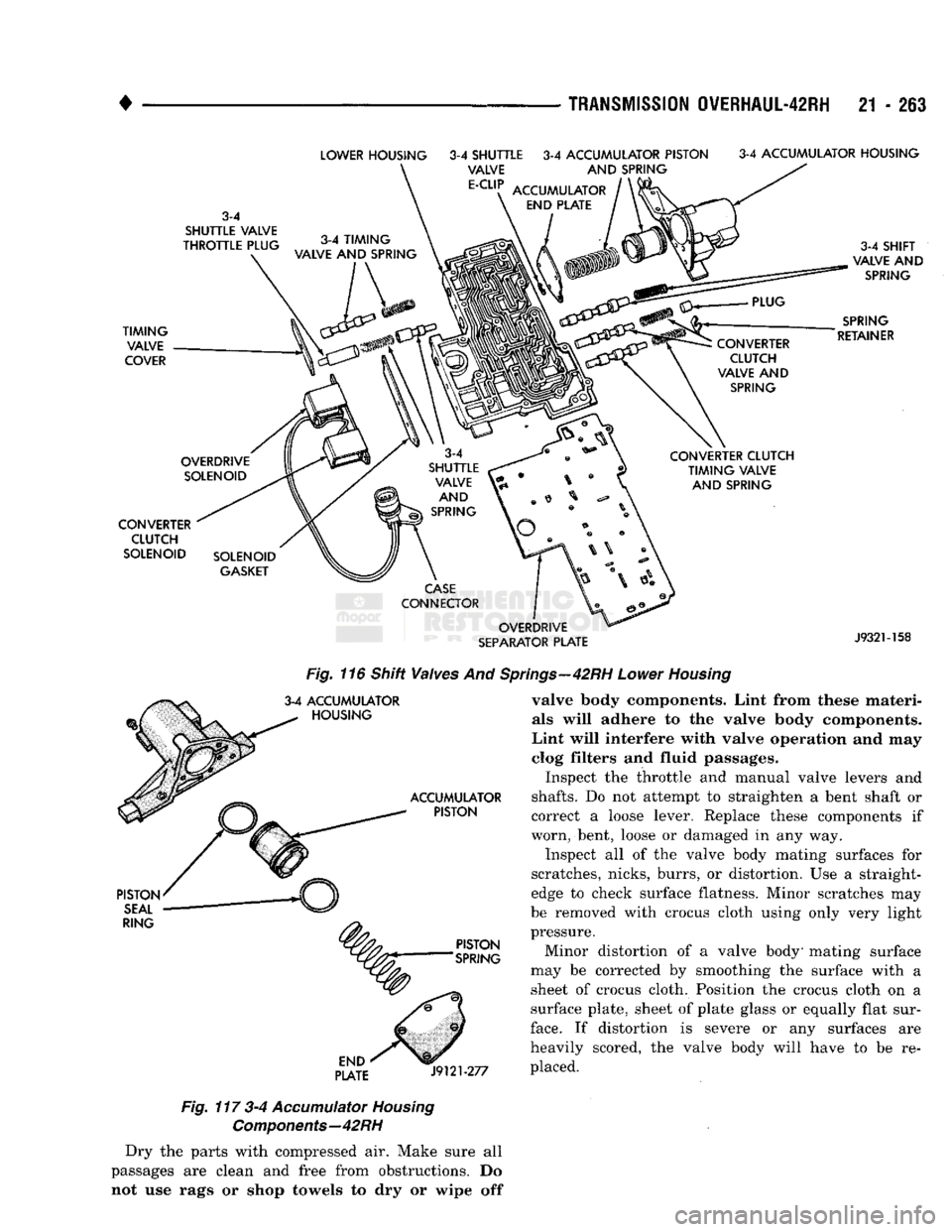
4
TRANSMISSION
QVERHAUL-42RH
21 - 263
Fig.
116 Shift Valves And 3-4 ACCUMULATOR
^ HOUSING
PLATE
J9121-277
Fig.
117 3-4
Accumulator
Housing
Components—42
RH
Dry the parts with compressed air. Make sure all
passages are clean and free from obstructions. Do not use rags or shop towels to dry or wipe off
wings—42RH
Lower
Housing
valve body components. Lint from these materials will adhere to the valve body components.
Lint will interfere with valve operation and may
clog filters and fluid passages.
Inspect the throttle and manual valve levers and
shafts.
Do not attempt to straighten a bent shaft or
correct a loose lever. Replace these components if
worn, bent, loose or damaged in any way.
Inspect all of the valve body mating surfaces for
scratches, nicks, burrs, or distortion. Use a straight
edge to check surface flatness. Minor scratches may
be removed with crocus cloth using only very light
pressure.
Minor distortion of a valve body' mating surface
may be corrected by smoothing the surface with a sheet of crocus cloth. Position the crocus cloth on a
surface plate, sheet of plate glass or equally flat sur
face.
If distortion is severe or any surfaces are
heavily scored, the valve body will have to be re
placed.
Page 1265 of 1502
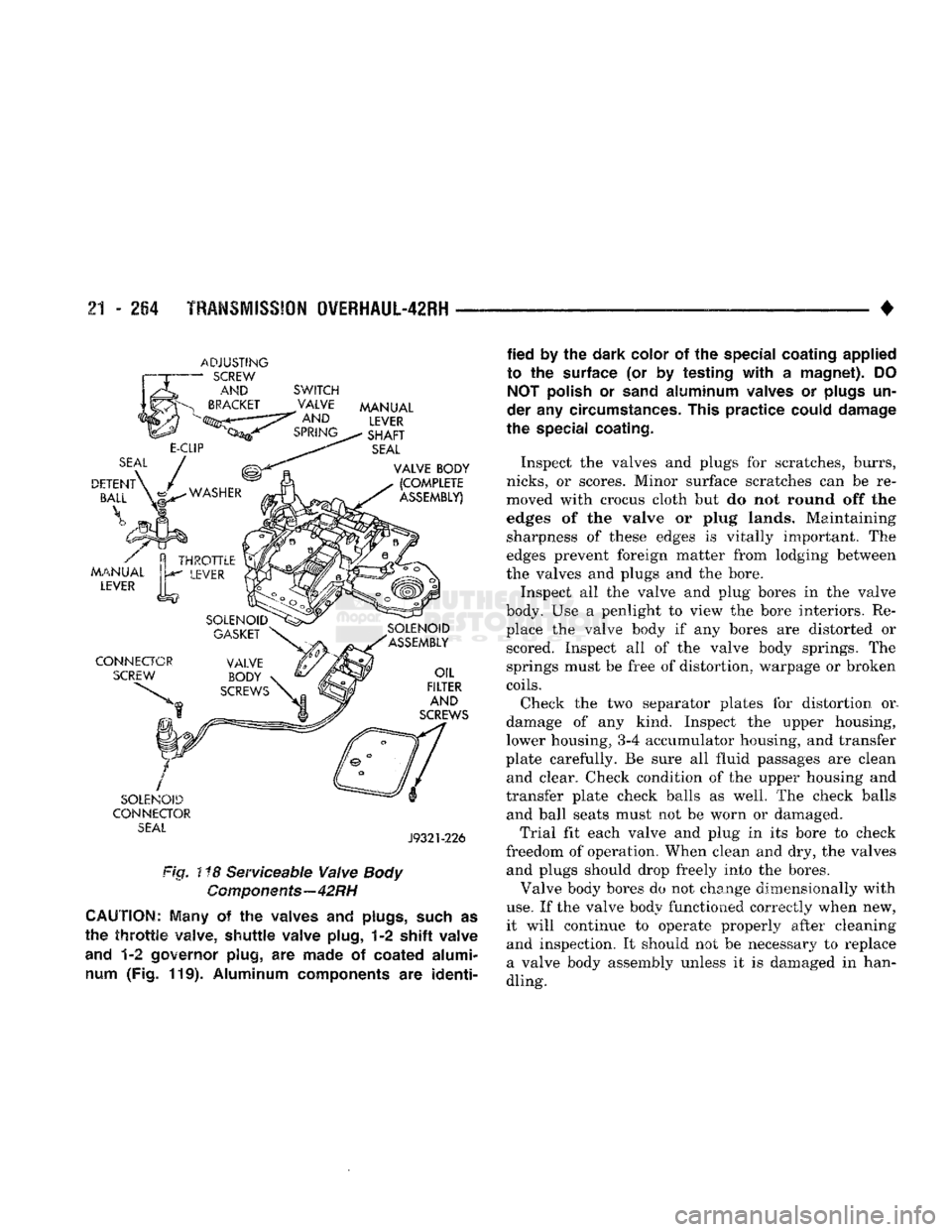
21
- 264
TRANSMISSION QVERHAUL-42RH
ADJUSTING
-
SCREW
AND
SWITCH
CONNECTOR
SEAL
J9321-226
Fig. ! *8 Serviceable Valve
Body
Components—42RH
CAUTION;
Many
of the
waives
and
plugs,
such
as
the
throttle
valve,
shuttle
valve plug,
1-2 shift
valve
and
1-2
governor plug,
are
made
of
coated alumi num
(Fig. 119).
Aluminum components
are
identi
fied
by the
dark color
of the
special coating applied
to
the
surface
(or by
testing
with
a
magnet).
DO
NOT
polish
or
sand
aluminum valves
or
plugs
un
der
any
circumstances. This practice could damage
the special coating.
Inspect the valves and plugs for scratches, burrs,
nicks,
or scores. Minor surface scratches can be re
moved with crocus cloth but do not round off the
edges of the valve or plug lands. Maintaining sharpness of these edges is vitally important. The
edges prevent foreign matter from lodging between
the valves and plugs and the bore.
Inspect all the valve and plug bores in the valve
body. Use a penlight to view the bore interiors. Re place the valve body if any bores are distorted or scored. Inspect all of the valve body springs. The
springs must be free of distortion, warpage or broken
coils.
Check the two separator plates for distortion or.
damage of any kind. Inspect the upper housing,
lower housing,
3-4
accumulator housing, and transfer
plate carefully. Be sure all fluid passages are clean and clear. Check condition of the upper housing and
transfer plate check balls as well. The check balls and ball seats must not be worn or damaged.
Trial fit each valve and plug in its bore to check
freedom of operation. When clean and dry, the valves and plugs should drop freely into the bores.
Valve body bores do not change dimensionally with
use.
If the valve body functioned correctly when new,
it will continue to operate properly after cleaning and inspection. It should not be necessary to replace
a valve body assembly unless it is damaged in han
dling.
Page 1266 of 1502
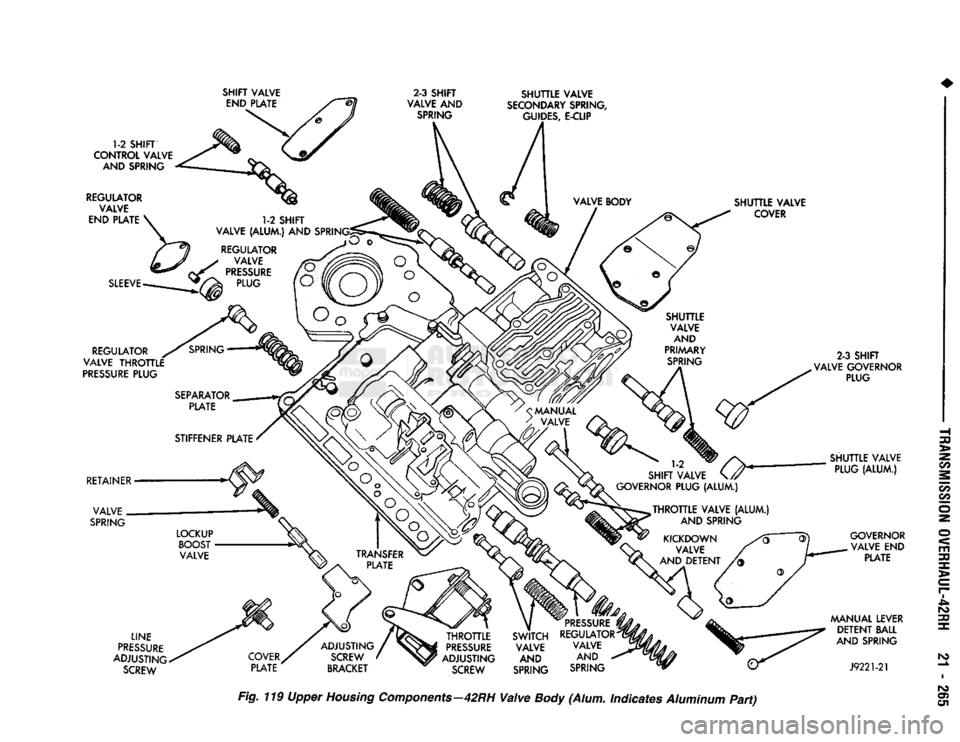
SHIFT VALVE
END
PLATE
2-3
SHIFT
VALVE AND
SPRING
SHUTTLE VALVE
SECONDARY
SPRING,
GUIDES,
E-CLIP
1-2 SHIFT
CONTROL VALVE AND
SPRING
REGULATOR VALVE
END
PLATE SHUTTLE VALVE
COVER
SLEEVE
REGULATOR
VALVE THROTTLE
PRESSURE
PLUG
RETAINER VALVE
SPRING
2-3 SHIFT
VALVE GOVERNOR PLUG
LINE
PRESSURE
ADJUSTING-
SCREW
ADJUSTING
SCREW
BRACKET
PRESSURE
SWITCH REGULATOR* VALVE VALVE AND
AND
SPRING SPRING
SHUTTLE VALVE
PLUG
(ALUM.)
GOVERNOR
VALVE END PLATE
MANUAL LEVER DETENT BALL
AND
SPRING
J9221-21
Fig. 119 Upper Housing Components-42RH Valve Body (Alum. Indicates Aluminum Part)
Page 1267 of 1502
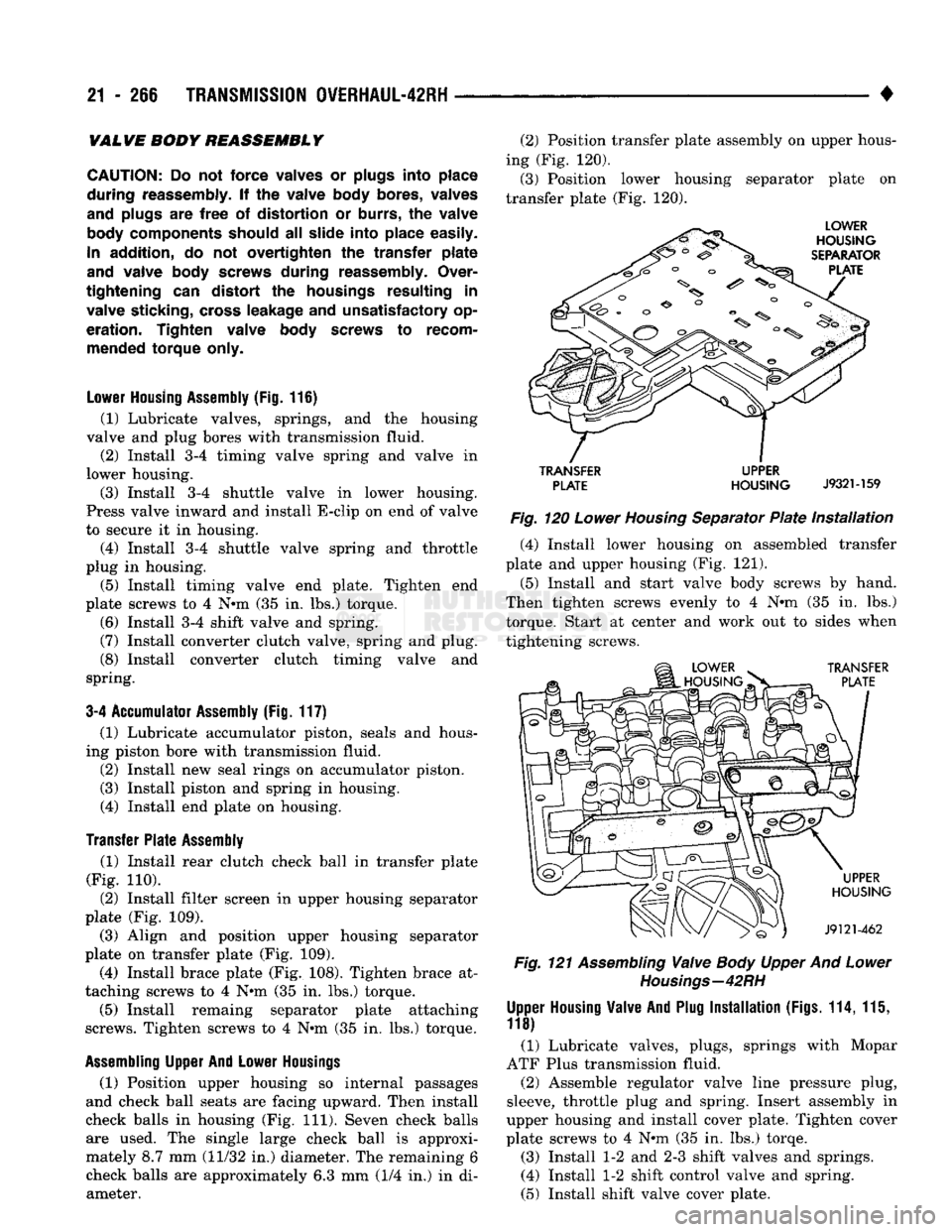
21
- 266
TRANSMISSION
OWERHAUL-42RH
•
VALVE
BODY REASSEMBLY
CAUTION:
Do not
force
valves or plugs
into
place
during
reassembly. If the valve body
bores,
valves
and
plugs are
free
of
distortion
or burrs, the valve body components should all slide
into
place easily.
In
addition,
do not
overtighten
the
transfer
plate
and
valve body
screws
during
reassembly. Over
tightening
can
distort
the
housings
resulting
in
valve sticking,
cross
leakage and unsatisfactory op
eration.
Tighten valve body
screws
to recom mended
torque
only.
Lower
Housing
Assembly
(Fig. 116)
(1) Lubricate valves, springs, and the housing
valve and plug bores with transmission fluid.
(2) Install 3-4 timing valve spring and valve in
lower housing.
(3) Install 3-4 shuttle valve in lower housing.
Press valve inward and install E-clip on end of valve
to secure it in housing. (4) Install 3-4 shuttle valve spring and throttle
plug in housing.
(5)
Install timing valve end plate. Tighten end
plate screws to 4 N«m (35 in. lbs.) torque.
(6) Install 3-4 shift valve and spring.
(7) Install converter clutch valve, spring and plug.
(8) Install converter clutch timing valve and
spring.
3-4
Accumulator
Assembly
(Fig. 117) (1) Lubricate accumulator piston, seals and hous
ing piston bore with transmission fluid. (2) Install new seal rings on accumulator piston.
(3) Install piston and spring in housing. (4) Install end plate on housing.
Transfer Plate
Assembly
(1) Install rear clutch check ball in transfer plate
(Fig. 110). (2) Install filter screen in upper housing separator
plate (Fig. 109). (3) Align and position upper housing separator
plate on transfer plate (Fig. 109).
(4) Install brace plate (Fig. 108). Tighten brace at
taching screws to 4 N«m (35 in. lbs.) torque. (5) Install remaing separator plate attaching
screws. Tighten screws to 4 Nrn (35 in. lbs.) torque.
Assembling
Upper And Lower
Housings
(1) Position upper housing so internal passages
and check ball seats are facing upward. Then install
check balls in housing (Fig. 111). Seven check balls are used. The single large check ball is approxi
mately 8.7 mm (11/32 in.) diameter. The remaining 6 check balls are approximately 6.3 mm (1/4 in.) in di ameter. (2) Position transfer plate assembly on upper hous
ing (Fig. 120).
(3) Position lower housing separator plate on
transfer plate (Fig. 120).
TRANSFER
UPPER
PLATE
HOUSING
J932M59
Fig.
120
Lower
Housing
Separator
Plate
Installation
(4) Install lower housing on assembled transfer
plate and upper housing (Fig. 121).
(5) Install and start valve body screws by hand.
Then tighten screws evenly to 4
N*m
(35 in. lbs.) torque. Start at center and work out to sides when
tightening screws.
Fig.
121
Assembling
Valve
Body
Upper And
Lower
Housings—42
RH
Upper
Housing
Valve And
Plug
Installation
(Figs.
114, 115,
118)
(1) Lubricate valves, plugs, springs with Mopar
ATF Plus transmission fluid.
(2) Assemble regulator valve line pressure plug,
sleeve, throttle plug and spring. Insert assembly in
upper housing and install cover plate. Tighten cover
plate screws to 4
N*m
(35 in. lbs.) torqe.
(3) Install 1-2 and 2-3 shift valves and springs.
(4) Install 1-2 shift control valve and spring.
(5) Install shift valve cover plate.
Page 1268 of 1502
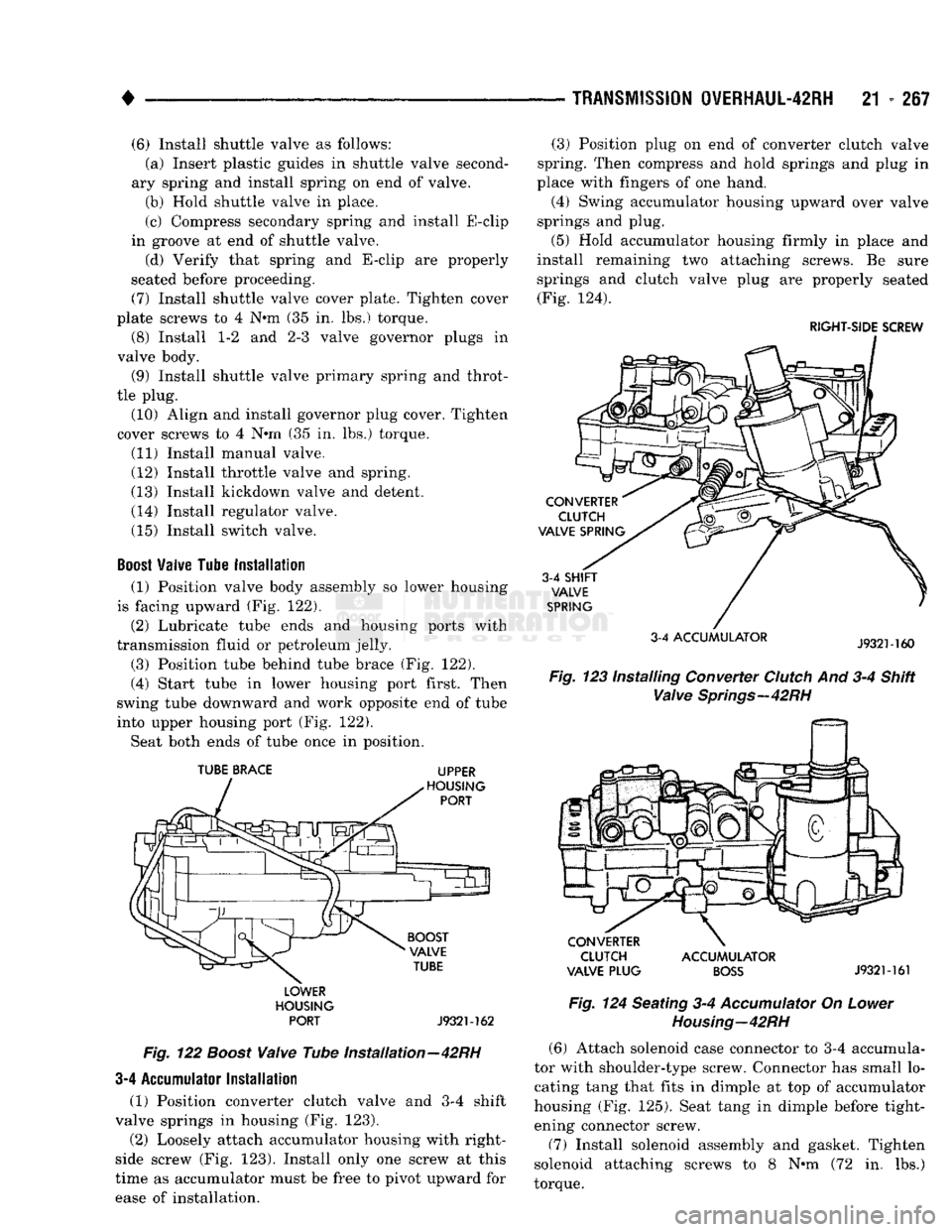
•
TRANSMISSION
0VERHAUL-42RH
21 - 267 (6) Install shuttle valve as follows:
(a) Insert plastic guides in shuttle valve second
ary spring and install spring on end of valve. (b) Hold shuttle valve in place.
(c) Compress secondary spring and install E-clip
in groove at end of shuttle valve. (d) Verify that spring and E-clip are properly
seated before proceeding.
(7) Install shuttle valve cover plate. Tighten cover
plate screws to 4 N*m (35 in. lbs.) torque.
(8) Install 1-2 and 2-3 valve governor plugs in
valve body.
(9) Install shuttle valve primary spring and throt
tle plug. (10) Align and install governor plug cover. Tighten
cover screws to 4 N#rn (35 in. lbs.) torque.
(11) Install manual valve.
(12) Install throttle valve and spring.
(13) Install kickdown valve and detent.
(14) Install regulator valve. (15) Install switch valve.
Boost
Valve Tube Installation (1) Position valve body assembly so lower housing
is facing upward (Fig. 122).
(2) Lubricate tube ends and housing ports with
transmission fluid or petroleum jelly.
(3) Position tube behind tube brace (Fig. 122).
(4) Start tube in lower housing port first. Then
swing tube downward and work opposite end of tube into upper housing port (Fig. 122).
Seat both ends of tube once in position.
TUBE
BRACE
UPPER
LOWER
HOUSING PORT
J932M62
Fig.
122
Boost
Vaive
Tube Installation-42RH 3-4
Accumulator
Installation
(1) Position converter clutch valve and 3-4 shift
valve springs in housing (Fig. 123).
(2) Loosely attach accumulator housing with right-
side screw (Fig. 123). Install only one screw at this
time as accumulator must be free to pivot upward for ease of installation. (3) Position plug on end of converter clutch valve
spring. Then compress and hold springs and plug in
place with fingers of one hand.
(4) Swing accumulator housing upward over valve
springs and plug.
(5) Hold accumulator housing firmly in place and
install remaining two attaching screws. Be sure
springs and clutch valve plug are properly seated (Fig. 124).
RIGHT-SIDE
SCREW
3-4
ACCUMULATOR
Fig.
123 Installing Converter
Clutch
And 3-4 Shift
Valve
Springs—42RH
CLUTCH ACCUMULATOR
VALVE PLUG
BOSS
J932M61
Fig.
124 Seating 3-4
Accumulator
On
Lower
Housing—42RH
(6) Attach solenoid case connector to 3-4 accumula
tor with shoulder-type screw. Connector has small lo cating tang that fits in dimple at top of accumulator
housing (Fig. 125). Seat tang in dimple before tight ening connector screw.
(7) Install solenoid assembly and gasket. Tighten
solenoid attaching screws to 8 N*m (72 in. lbs.)
torque.
Page 1269 of 1502
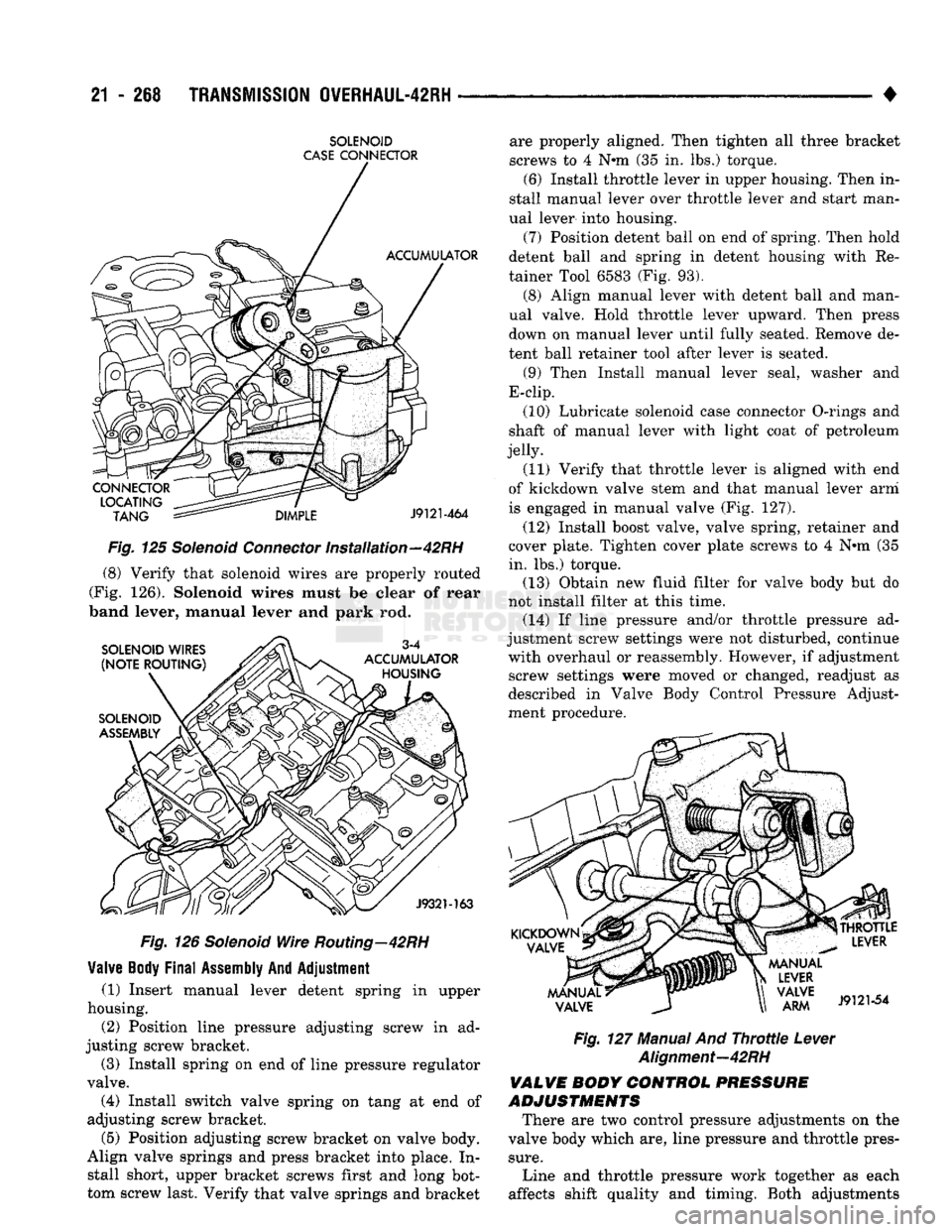
21
- 268
TRANSMISSION
OVERHAUL-42RH
SOLENOID
CASE
CONNECTOR
Fig. 125 Solenoid Connector Installation—42RH (8) Verify that solenoid wires are properly routed
(Fig. 126). Solenoid wires must be clear of rear
band lever, manual lever and
park
rod.
Fig, 126 Solenoid Wire Routing—42RH
Valve
Body
Final
Assembly
And
Adjustment
(1) Insert manual lever detent spring in upper
housing. (2) Position line pressure adjusting screw in ad
justing screw bracket.
(3) Install spring on end of line pressure regulator
valve. (4) Install switch valve spring on tang at end of
adjusting screw bracket.
(5) Position adjusting screw bracket on valve body.
Align valve springs and press bracket into place. In stall short, upper bracket screws first and long bot
tom screw last. Verify that valve springs and bracket _ . . _ +
Fig. 127 Manual And Throttle Lever
Alignment-42RH
VALVE
BODY CONTROL PRESSURE
ADJUSTMENTS
There are two control pressure adjustments on the
valve body which are, line pressure and throttle pres
sure.
Line and throttle pressure work together as each
affects shift quality and timing. Both adjustments are properly aligned. Then tighten all three bracket
screws to 4 N*m (35 in. lbs.) torque.
(6) Install throttle lever in upper housing. Then in
stall manual lever over throttle lever and start man
ual lever into housing.
(7) Position detent ball on end of spring. Then hold
detent ball and spring in detent housing with Re
tainer Tool 6583 (Fig. 93).
(8) Align manual lever with detent ball and man
ual valve. Hold throttle lever upward. Then press down on manual lever until fully seated. Remove de
tent ball retainer tool after lever is seated.
(9) Then Install manual lever seal, washer and
E-clip.
(10) Lubricate solenoid case connector O-rings and
shaft of manual lever with light coat of petroleum
jelly.
(11) Verify that throttle lever is aligned with end
of kickdown valve stem and that manual lever arm
is engaged in manual valve (Fig. 127).
(12) Install boost valve, valve spring, retainer and
cover plate. Tighten cover plate screws to 4 N*m (35
in. lbs.) torque. (13) Obtain new fluid filter for valve body but do
not install filter at this time. (14) If line pressure and/or throttle pressure ad
justment screw settings were not disturbed, continue with overhaul or reassembly. However, if adjustment screw settings were moved or changed, readjust as
described in Valve Body Control Pressure Adjust
ment procedure.
Page 1270 of 1502
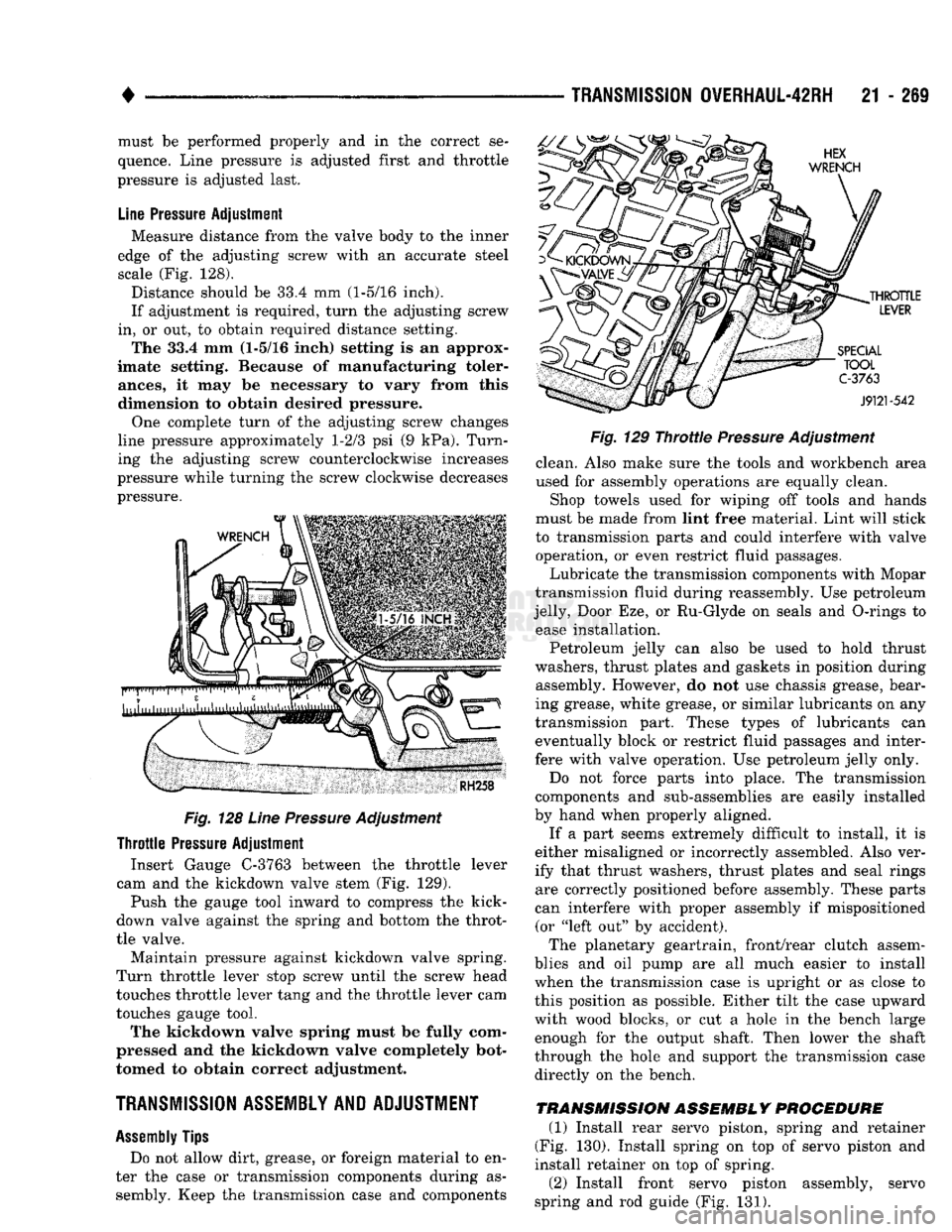
•
TRANSMISSION
OVERHAUL-42RH
21 - 269 must be performed properly and in the correct se
quence. Line pressure is adjusted first and throttle
pressure is adjusted last.
Line
Pressure
Adjustment
Measure distance from the valve body to the inner
edge of the adjusting screw with an accurate steel
scale (Fig. 128).
Distance should be 33.4 mm (1-5/16 inch).
If adjustment is required, turn the adjusting screw
in, or out, to obtain required distance setting. The 33.4 mm (1-5/16 inch) setting is an approx
imate setting. Because of manufacturing toler
ances,
it may be necessary to vary from this
dimension to obtain desired pressure.
One complete turn of the adjusting screw changes
line pressure approximately 1-2/3 psi (9 kPa). Turn
ing the adjusting screw counterclockwise increases
pressure while turning the screw clockwise decreases
pressure.
Fig.
128
Line
Pressure
Adjustment
Throttle
Pressure
Adjustment Insert Gauge C-3763 between the throttle lever
cam and the kickdown valve stem (Fig. 129).
Push the gauge tool inward to compress the kick-
down valve against the spring and bottom the throt
tle valve.
Maintain pressure against kickdown valve spring.
Turn throttle lever stop screw until the screw head
touches throttle lever tang and the throttle lever cam
touches gauge tool.
The kickdown valve spring must be fully com
pressed and the kickdown valve completely bot
tomed to obtain correct adjustment.
TRANSMISSION ASSEMBLY AND ADJUSTMENT
Assembly
Tips
Do not allow dirt, grease, or foreign material to en
ter the case or transmission components during as sembly. Keep the transmission case and components
Fig.
129
Throttie
Pressure
Adjustment
clean. Also make sure the tools and workbench area
used for assembly operations are equally clean.
Shop towels used for wiping off tools and hands
must be made from lint free material. Lint will stick
to transmission parts and could interfere with valve operation, or even restrict fluid passages.
Lubricate the transmission components with Mopar
transmission fluid during reassembly. Use petroleum
jelly, Door Eze, or Ru-Glyde on seals and O-rings to ease installation.
Petroleum jelly can also be used to hold thrust
washers, thrust plates and gaskets in position during assembly. However, do not use chassis grease, bear
ing grease, white grease, or similar lubricants on any
transmission part. These types of lubricants can eventually block or restrict fluid passages and inter
fere with valve operation. Use petroleum jelly only.
Do not force parts into place. The transmission
components and sub-assemblies are easily installed
by hand when properly aligned.
If a part seems extremely difficult to install, it is
either misaligned or incorrectly assembled. Also ver
ify that thrust washers, thrust plates and seal rings are correctly positioned before assembly. These parts
can interfere with proper assembly if mispositioned (or "left out" by accident).
The planetary geartrain, front/rear clutch assem
blies and oil pump are all much easier to install
when the transmission case is upright or as close to
this position as possible. Either tilt the case upward
with wood blocks, or cut a hole in the bench large enough for the output shaft. Then lower the shaft
through the hole and support the transmission case
directly on the bench.
TRANSMISSION ASSEMBLY PROCEDURE
(1) Install rear servo piston, spring and retainer
(Fig. 130). Install spring on top of servo piston and
install retainer on top of spring.
(2) Install front servo piston assembly, servo
spring and rod guide (Fig. 131).